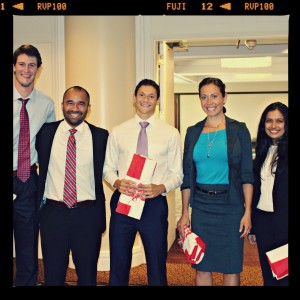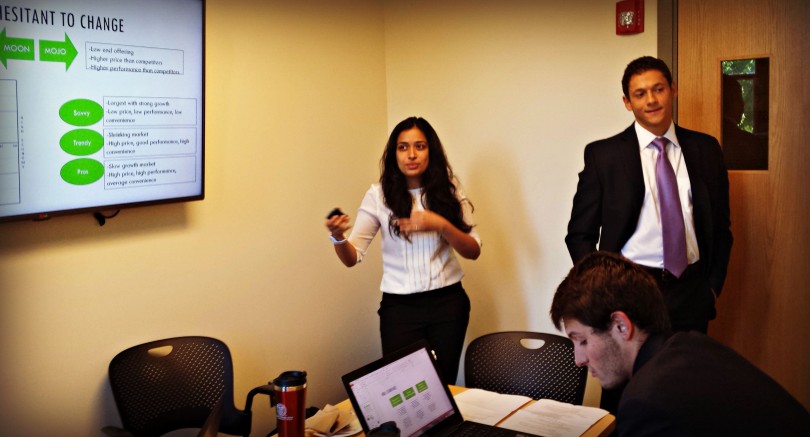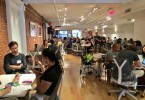I am what they call a “double switcher”. Most veterans are. A double switcher is someone switching functional positions and industry targets. Double switchers fight an uphill battle in the MBA world because they have no experience in what they are getting into and haven’t been tested. To get hired as a double switcher, you have to be very persuasive about what you bring to the table. That is why I am so amped on joining competitions outside of my comfort zone. It is my chance to prove my skills and ability to learn quickly. So far I have competed in a Hackathon where I led a 4-man team in creating a business idea, prototyping it, and pitching it to judges. We became finalists in that competition and I was able to prove my leadership and ability to take an idea from my head into a legitimate presentation. At Cornell University, the Johnson School of Management just held a Marketing Case Competition. I looked at this competition as another opportunity to prove myself. Out of 23 teams, my team took 1st Place. I was very proud of them. This is how we did it:
This is how we did it:
In the competition, we first had to complete a simulation where we managed the marketing strategy of a fake company for 5 years. The keys to success in this simulation turned out to be understanding what the consumer wants and staying ahead of where their demands are trending. However, you can’t get too far ahead of their demand or else you will be paying for costs in your production that the consumer doesn’t even care that you provide. I think this is reflected in my Samsung Galaxy’s ability to “Smart Scroll”. I don’t ever use that feature because I feel my finger is more accurate for scrolling. They could have saved a few bucks per phone by not offering that feature. Another strategy we followed was targeting our two products to only two segments in the market. There were three segments to consider marketing to, but marketing to all three would reduce our resources and make us good at a lot of things but not great at anything. At the end of the competition, we almost tripled our revenues and performed relatively well.
However, the competition was in the presentation of the results and not in the results itself. This is where we had the opportunity to distinguish ourselves. The normal approach would be to present a slide with an agenda, talk about assumptions, throw a bunch of stats and charts on the screen and end it all with a Questions slide. As the leader of my team I didn’t want our team to be lost in the masses of mediocrity. We needed to stand out and the key to that was engagement with the audience. I have been reading the book How to Deliver a TED Talk recently and wanted to craft our presentation using tips gained from that book. Essentially, I wanted to take our audience on an emotional ride through our experience. We wanted to emphasize despair in our challenges, which for us happened at the onset of our simulation. By displaying our biggest mistake we were able to take the audience through a multitude of decisions we made to crawl out of the negative and succeed in the end. Additional touches I learned from TED talks was to start with a question that got the audience to think and personalize with our message. It should be a questions that starts with either “Why “or “How” and include the word “you” in it. So I started the presentation with “Why would you elect to attend a full-time in-residence MBA, when that same school offers other alternatives for an MBA education?” We used this question to draw parallels with the two products we had to design a marketing plan for. The other touch we added came at the end in the form of a tagline. Something that is catchy and stays in the mind of the audience after you’ve left. The book suggests using a paired tagline where the first sentence is a negative and the second sentence is a positive. Simon Sinek uses the tagline “People don’t buy WHAT you do, they buy WHY you do it.” in his talk “How Great Leaders Inspire Action“. Referencing finding the market consumer trends and staying ahead of it, we decided to use the tagline “Don’t ride the wave, Be the wave.” I knew this worked because multiple people came up to me hours later and quoted the tagline back to me (albeit in jest). Johnson Business School even quoted me in a tweet.
Once we finished our presentation I knew we had killed it and did something that set us apart from others. There was high risk but the potential for reward was even higher. I learned exactly what I wanted out of the experience. I wanted to challenge my team to do something new and creative. I wanted to challenge myself to be able to lead in that environment. However, getting a group of people to sign on to a vision of mine when the easier route would be to simply do the status quo was tough. Being creative requires brainstorming and conversations that take time, and time during a case competition is an extreme luxury. In order to keep people’s attention so they do not give up hope on my vision, I had to be on the ball with the pace of discussion and build excitement about the interim progress we were making. An additional challenge was in the oral presentation where we had to work on delivery of our speech. The idea behind our delivery was high resolution pictures on our screen and fluid interaction with the audience without looking at our own screen. I almost felt like a college football coach giving a pump up pre-game speech to motivate my team to go out there and present something unique and special. And the team delivered.
I’ve now taken down two competitions outside of my comfort level and am still searching for more competitions to continue to broaden my skillset. I’m loving it.




